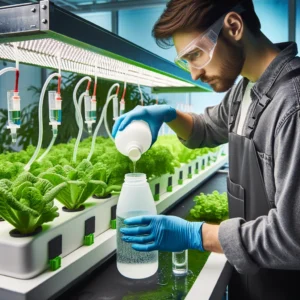
How to Raise PH Levels in Hydroponics
Maintaining the correct pH level is crucial for the success of any hydroponic garden. pH measures the acidity or alkalinity of your nutrient solution, and it directly impacts your plants’ ability to absorb the nutrients they need to thrive. If your hydroponic system’s pH drops too low, your plants may exhibit signs of stress like stunted growth, nutrient deficiencies, or yellowing leaves.
Understanding how to raise pH in hydroponics is essential for addressing this common issue. Many factors can contribute to low pH in hydroponics, and there are various methods to increase it safely and effectively.
This guide will delve into the causes of low pH in hydroponics, teach you how to raise pH levels using different solutions, and provide tips for preventing future pH fluctuations. With the right knowledge, you can ensure your hydroponic plants have the optimal environment to flourish.
Understanding pH in Hydroponics
What is pH?
- The pH scale measures how acidic or alkaline a solution is, ranging from 0 (highly acidic) to 14 (highly alkaline), with 7 being neutral. In hydroponics, we focus on a smaller, more precise portion of this scale.
Optimal pH
- Most hydroponic plants thrive in a slightly acidic pH range between 5.5 and 6.5. Within this range, the essential nutrients in your hydroponic solution are most readily available for plant uptake.
Importance of pH
- If the pH of your nutrient solution strays too far outside the optimal range, your plants may struggle to absorb nutrients, even if they are abundant. This can lead to deficiencies, stunted growth, root problems, and overall poor plant health. A stable, appropriate pH is crucial for a successful hydroponic system.
Causes of Low pH in Hydroponics
Several factors can contribute to a drop in pH within your hydroponic system. Understanding the common culprits is essential for both correcting and preventing future pH imbalances.
Nutrient uptake
- Plants naturally tend to absorb more negatively charged ions (anions) from the nutrient solution than positively charged ions (cations). This imbalance leaves behind excess hydrogen ions (H+), which increases acidity and lowers the pH.
Types of fertilizers
- Some hydroponic fertilizers are naturally more acidic than others. Ammonium-based fertilizers, for instance, can contribute to a decrease in pH over time.
CO2 injection
- If you supplement your hydroponic system with carbon dioxide (CO2) to boost plant growth, this can dissolve in your nutrient solution, forming carbonic acid and lowering the pH.
Root decomposition
- As roots naturally age and break down, or in the case of root diseases, organic matter is released into the solution. This decaying matter can release acids, leading to a drop in pH.
How to Raise pH in Hydroponics
Fortunately, there are several effective ways to raise the pH of your hydroponic nutrient solution. Let’s explore the most common options:
pH Up solutions
- These are commercially available products specifically designed to raise the pH of hydroponic nutrient solutions. They typically contain potassium hydroxide or potassium carbonate. Follow the instructions on the product label carefully, as overcorrecting can swing your pH too high.
Potassium hydroxide (KOH)
- This strong base is a highly effective way to raise pH. However, use extreme caution as even small amounts can cause significant pH changes. Precision in dosing is essential when using KOH.
Calcium hydroxide (CaOH)
- Also known as slaked lime, calcium hydroxide raises pH while offering the added benefit of supplementing calcium, a vital plant nutrient.
Baking soda (sodium bicarbonate)
- A common household item, baking soda can temporarily raise pH in a pinch. However, it lacks the precision and stability of dedicated pH adjustment products.
Wood ash
- Wood ash can naturally raise pH, but its effects are less predictable than commercial solutions. The source of the wood ash matters, and it’s essential to test your wood ash solution before adding it to your system.
Important Reminder: Always start with small amounts of your chosen pH adjustment solution and gradually increase the dosage until you reach the desired pH level. Monitor the change closely to avoid overshooting your target pH.
Preventing pH Fluctuations
While knowing how to raise your pH is important, taking steps to prevent large fluctuations will save you time and effort in the long run. Here are a few key strategies:
Regular monitoring
- The best way to catch pH changes early is to test your nutrient solution regularly. Use a reliable pH meter and aim to test at least once a day, especially during periods of rapid plant growth.
Buffering solutions
- Hydroponic buffering solutions are designed to help resist changes in pH, keeping it more stable. Consider adding a buffering solution to your system if you experience frequent pH fluctuations.
Water source
- The mineral content and initial pH of your water source can influence pH stability in your system. If your tap water is problematic, consider using reverse osmosis (RO) water which provides a cleaner base.
Choose your fertilizer wisely
- Some fertilizers are naturally more acidic than others. Selecting a fertilizer formulated for hydroponics and with a balanced pH impact can help minimize pH drops.
Reservoir maintenance
- Regularly cleaning your reservoir and removing any dead plant matter will help prevent the buildup of organic acids that can lower pH.
Additional Tips
- Small adjustments: Always make gradual changes to your pH. Sudden, drastic shifts can stress your plants.
- Patience: pH adjustments can take some time to fully register throughout your hydroponic system. Allow time for the solution to circulate and stabilize before retesting.
- Addressing root causes: If you find yourself constantly battling low pH, consider whether your fertilizer choice or other underlying factors might be contributing to the issue.
- Recordkeeping: Keep track of the pH adjustments you make, including the products and amounts used. This can help you fine-tune your process and identify patterns over time.
- Experiment safely: Every hydroponic system is slightly different. Experiment with different pH adjustment methods in small amounts to find what works best for your setup and plants.
To Sum it Up
Understanding and managing pH levels is an essential aspect of maintaining a healthy and thriving hydroponic garden. By recognizing the causes of low pH, utilizing appropriate adjustment methods, and implementing preventive strategies, you can ensure your plants have access to the nutrients they need to flourish.
Remember, maintaining the optimal pH range requires some attention and occasional adjustments. With a little practice and the knowledge from this guide, you’ll be well-equipped to master pH control in your hydroponic system and reap the rewards of vibrant, healthy plants.
FAQ: Raising pH in Hydroponics
Q1: How often should I check the pH of my hydroponic system?A1: Ideally, check the pH daily, especially during stages of rapid plant growth. This allows you to catch and correct any fluctuations quickly.
Q2: Can I use vinegar to lower pH and baking soda to raise it?A2: While vinegar and baking soda can temporarily alter pH, they lack precision and don’t provide long-term stability. It’s best to use products specifically designed for hydroponic pH adjustment.
Q3: What if my pH keeps dropping even after adjustments?A3: If you experience recurring pH drops, consider these potential causes:
- Your fertilizer might be too acidic.
- Root decay could be releasing organic acids.
- Your water source might be influencing pH stability.
Q4: Is it better to have a slightly high or slightly low pH?A4: It’s generally better to err slightly on the lower side of the optimal pH range (around 5.5). This is because some nutrients become less available as the pH gets too high.
Q5: Will raising the pH harm my plants?A5: Sudden, drastic changes in pH can shock your plants. Always make gradual adjustments and monitor your plants closely for any signs of stress.

